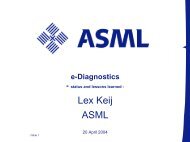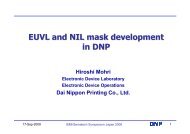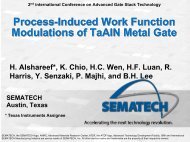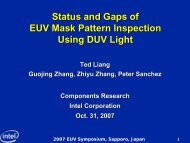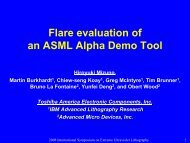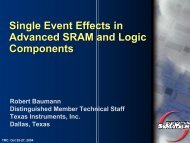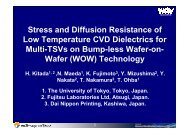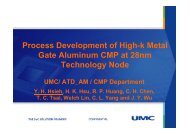Welcome to the ISMI 450mm Industry Briefing Welcome ... - Sematech
Welcome to the ISMI 450mm Industry Briefing Welcome ... - Sematech
Welcome to the ISMI 450mm Industry Briefing Welcome ... - Sematech
- No tags were found...
Create successful ePaper yourself
Turn your PDF publications into a flip-book with our unique Google optimized e-Paper software.
SEMICON West 2007<strong>Welcome</strong><strong>to</strong> <strong>the</strong><strong>ISMI</strong><strong>450mm</strong><strong>Industry</strong><strong>Briefing</strong>Advanced Materials Research Center, AMRC, International SEMATECHManufacturing Initiative, and <strong>ISMI</strong> are servicemarks of SEMATECH, Inc.SEMATECH, <strong>the</strong> SEMATECH logo, Advanced Technology Development Facility,ATDF, and <strong>the</strong> ATDF logo are registered servicemarks of SEMATECH, Inc. All1o<strong>the</strong>r servicemarks and trademarks are <strong>the</strong> property of <strong>the</strong>ir respective owners.
Meeting Outline• Provide overview of <strong>the</strong> <strong>ISMI</strong> <strong>450mm</strong>program– Outline manufacturing productivity andeconomic assumptions on which programis based– Describe analysis of 300mmPrime potentialand <strong>the</strong> implications <strong>to</strong> <strong>450mm</strong>– Describe Next Generation Fac<strong>to</strong>ry Visionand Guidelines2
<strong>ISMI</strong> Members14members4
300mm Transition Lessons Learned– <strong>Industry</strong> coordination is crucial; early engagement ofequipment and materials manufacturers• Determine fab architecture• Develop standards early• Consider bridge <strong>to</strong>ols– Support multiple leading-edge business models• High-volume/low-mix, High-volume/high-mix, etc.– Assess business and economic models• Analyze cost, risk, benefit/ROI– Continuously evaluate and adjust, including:• Impact of technology on timing• Market and industry dynamics5
<strong>450mm</strong> Issues• ROI– Cost– Source of R&D funding• Timing– Economics: product demand, industry cycles– Equipment capability & performance• Technical feasibility– Silicon material: challenges for <strong>450mm</strong> wafermanufacturing– Processes: robust unit processes across<strong>450mm</strong> wafers, uniformity6
<strong>ISMI</strong> Approach• Understand economic impact onindustry– Opportunity <strong>to</strong> use modeling forcareful analysis• Build industry consensus– Equipment, materials, and chipmanufacturers working <strong>to</strong>ge<strong>the</strong>r• Build from lessons learned in 300mmtransition7
Benefits of <strong>the</strong> 300mmPrime / <strong>450mm</strong> Path• Target 300mmPrime redesigns <strong>to</strong> resolvebiggest cost, productivity and cycle timelimiters known from 300mm experience– Create upgrades <strong>to</strong> 300mm fab designs for acontinuum of benefits and revenue• Port 300mmPrime learnings <strong>to</strong> <strong>450mm</strong> designs– Lower risk of major transitional changes– Lower developmental costs by demonstratingconcepts at <strong>the</strong> cheaper 300mm wafer size8
Perspective on <strong>ISMI</strong> Direction• <strong>ISMI</strong> has developed a comprehensive strategy fornear- and long-term productivity improvements– Next Generation Fac<strong>to</strong>ry Vision and Guidelines covers <strong>the</strong>continuum of existing and future fabs from 300mm <strong>to</strong> <strong>450mm</strong>• An analysis of potential 300mm improvements shows300mmPrime has cycle time opportunity but fallsshort of <strong>the</strong> traditional cost reduction required <strong>to</strong> stayon Moore's Law– Metric goal: 30% cost reduction and 50% cycle time improvement– The financial benefit of cycle time reduction is difficult <strong>to</strong> quantifyfor different business models• Faster new product introduction, time <strong>to</strong> money, faster productdelivery <strong>to</strong> cus<strong>to</strong>mers• <strong>ISMI</strong> has developed a complementary forwardcompatibleapproach of 300mmPrime <strong>to</strong> <strong>450mm</strong>– Addresses <strong>the</strong> needs of our various member constituencies– Attempts <strong>to</strong> minimize <strong>the</strong> R&D expenditure by <strong>the</strong> industry9‣Efficient use of industry resources is key
<strong>ISMI</strong> Perspective on <strong>450mm</strong>• <strong>ISMI</strong> will initiate a <strong>450mm</strong> Program dedicated<strong>to</strong> moving ahead with <strong>450mm</strong> industrycapability– New mission– New structure• <strong>ISMI</strong> plans <strong>to</strong> pursue in 2008– Availability of <strong>450mm</strong> silicon wafers– <strong>450mm</strong> Fac<strong>to</strong>ry Integration Guidelines & Standards– Creation of a <strong>450mm</strong> Fac<strong>to</strong>ry Integration Test Bed• Interoperability testing of pro<strong>to</strong>type au<strong>to</strong>mation andequipment interfaces11
Next Generation Fac<strong>to</strong>ry Vision Realization450-only450 Fac<strong>to</strong>ry IntegrationTest Bed450 Fac<strong>to</strong>ry IntegrationGuidelines & Standards450 Readiness450 Silicon Wafer12300mmPrimeSoftware InfrastructureSWP/Mini-batch FurnacesAvailability ImprovementFWD/setup Reduction300mmClassicFoundation• <strong>ISMI</strong> is moving forward with complementary forward-compatible paths for300mmPrime and <strong>450mm</strong>– Realization of <strong>450mm</strong> is built upon coordinated improvements from 300mmPrimeand 450-only activities <strong>to</strong> efficiently utilize industry resources• Collaboration is a critical success fac<strong>to</strong>r inside and outside <strong>ISMI</strong>
Summary• 300mmPrime has cycle time opportunities but does notsufficiently address cost reduction needs <strong>to</strong> replace <strong>450mm</strong>transition• <strong>ISMI</strong> has developed a complementary forward-compatibleapproach of 300mm <strong>to</strong> <strong>450mm</strong>– Addresses <strong>the</strong> needs of our various member constituencies– Attempts <strong>to</strong> minimize <strong>the</strong> R&D expenditure by <strong>the</strong> industry• Efficient use of industry resources is key• Implications <strong>to</strong> <strong>ISMI</strong> programs‣ Initiate tangible <strong>450mm</strong> activities <strong>to</strong> address long-termfundamental cost reduction• Cycle time also important for <strong>450mm</strong>‣ Pursue 300mm improvements <strong>to</strong> enable significantnear-term cycle time and cost reduction efforts‣ Initial 2008 activities efficiently guide two supplier groups‣ 300mmPrime: Process & Metrology Equipment‣ <strong>450mm</strong>: Silicon & Fac<strong>to</strong>ry Integration13
Agenda14(1:00) Introduction – Scott Kramer(1:15) Background – Tom Abell(1:35) 300mm Prime Analysis(1:35) Fac<strong>to</strong>ry Simulation – Robert Wright & Eddy Bass(2:10) Economic Analysis – Denis Fandel(2:45) Next Generation Fac<strong>to</strong>ry Vision– Tom Jefferson(3:15) Key Messages & Next Steps – Tom Abell(3:45) Summary/Closing – Scott Kramer(4:00) Adjourn[Note: Q&A time allowed in each presentation]
<strong>ISMI</strong> <strong>Industry</strong> <strong>Briefing</strong>July 16, 2007<strong>450mm</strong>ProgramBackgroundTom Abell<strong>ISMI</strong> <strong>450mm</strong> ProgramManager15
Productivity GapOptions <strong>to</strong> close gap:Higher IC prices (slowsgrowth); Lower DM profits(slows investment &Moore’s Law); Lower OEMprofits (weaker supplybase); Shared loss; orImproved productivitynear-term at 300mm andtransition <strong>to</strong> <strong>450mm</strong> forlong-term cost reduction$150 Billionproductivitygap by 2013$1 Trillionproductivitygap by 2024Slowed pace of technology,design shrinks, design layoutinnovations, etc50% increase in cost/transis<strong>to</strong>r by 201316
300 Prime Core Guiding Principles1. 300 Prime is a strategy for a 300mm productivitycontinuum bridge in <strong>the</strong> 450 mm transition2. An objective is <strong>to</strong> have forward-compatibility of <strong>the</strong>300 Prime design and architecture in <strong>the</strong> <strong>450mm</strong>fac<strong>to</strong>ry3. Business model consideration needs <strong>to</strong> be applied <strong>to</strong>both <strong>450mm</strong> and 300 Prime4. 300 Prime should provide productivity improvements(beyond 300 mm “classic”) that are scalable <strong>to</strong><strong>450mm</strong><strong>ISMI</strong> EAC18
<strong>ISMI</strong> 300 Prime/450 mm Core Targets1. Targets for 300 Prime or a 450 mm transition:• His<strong>to</strong>rical 30% cost reduction/cm 2 of processed siliconand• 50% cycle time reduction in days per mask layer for normalproduction lots2. Higher productivity and process controllability arerequired from process equipment, au<strong>to</strong>mation, andfac<strong>to</strong>ry systems3. First 300 Prime implementations are expectedaround 2008– Upgrades expected <strong>to</strong> deploy over several years– Adoption of 300 Prime is highly dependent uponrisk and ROI19
Productivity Detrac<strong>to</strong>rs• <strong>ISMI</strong> has compiled a list of “ProductivityDetrac<strong>to</strong>rs” based on:– Problems our members have <strong>to</strong>day…and...– Where our members want <strong>to</strong> be in <strong>the</strong> future• The rev.1 list is not a set of solutions• It is a set of descriptions of overriding issueswith explanations of <strong>the</strong>ir importance– These are <strong>the</strong> issues that need solving– Solutions may require improvement on severaldetrac<strong>to</strong>rs in order <strong>to</strong> realize productivity benefit– 28 “detrac<strong>to</strong>rs” have been identified so far..• List has been publicly published since Dec’06– No revisions <strong>to</strong> date20
“Blue Diamond” Background• 30% reduction in cost per area and 50% reduction in cycle timewere set as <strong>the</strong> targets for 300 Prime or <strong>450mm</strong> in Q2’06• Analysis of 300 Prime potential against targets was decided inQ3’06 for completion by Q2’07– Determine whe<strong>the</strong>r 300 Prime can be expected <strong>to</strong> deliver 30% cost reductionand 50% cycle time (Blue Diamond Analysis)• <strong>450mm</strong> could move out <strong>to</strong> an intermediate timeframe based on expectedbenefit of 300 PrimeOR• Accelerate <strong>450mm</strong> planning and development• Actions on 300 Prime analysis since SEMICON West 2006– >130 full fac<strong>to</strong>ry dynamic simulations for benefit analysis– Static fac<strong>to</strong>ry and economic modeling• ROI on improvement options (cost vs. benefit)– Development of Next Generation Fac<strong>to</strong>ry Vision as a unified<strong>450mm</strong>/300 Prime strategy.• Development of 19 Point Guidelines• Discussion/collaboration with SEMI and <strong>the</strong> industry during developmentprocess21
Blue Diamond Analysis Data• Fac<strong>to</strong>ry Simulations shown are based on 25-wafer carrier/lot size– Early 12-wafer simulations indicate greaterdependence on equipment improvements <strong>to</strong> returnexpected small lot cycle time benefits• Additional work is required <strong>to</strong> increase <strong>the</strong> confidencerequired for industry-level decision making• Economic analysis of cost vs. benefit formodeled scenario fac<strong>to</strong>rs/multi-fac<strong>to</strong>rs22
Agenda(1:00) Introduction – Scott Kramer(1:15) Background – Tom Abell(1:35) 300mm Prime Analysis(1:35) Fac<strong>to</strong>ry Simulation – Robert Wright & Eddy Bass(2:10) Economic Analysis – Denis Fandel(2:45) Next Generation Fac<strong>to</strong>ry Vision– Tom Jefferson(3:15) Key Messages & Next Steps – Tom Abell(3:45) Summary/Closing – Scott Kramer(4:00) Adjourn23[Note: Q&A time allowed in each presentation]
<strong>ISMI</strong> Rev.1 Productivity Detrac<strong>to</strong>rs List (1/4)1. Non-optimized output per capital dollar spent results indegraded fac<strong>to</strong>ry ROI2. Inability <strong>to</strong> meet short cycle times results in lost time <strong>to</strong> market3. Poor synchronization between process equipment, au<strong>to</strong>mationand fac<strong>to</strong>ry control systems reduces <strong>to</strong>tal fac<strong>to</strong>ry efficiency4. Unpredictable downtime of equipment induces disruption <strong>to</strong>fac<strong>to</strong>ry lot logistics reducing fac<strong>to</strong>ry efficiency and cycle time5. Delays in change-overs within process equipment negativelyimpacts cycle time (1st wafer delay, recipe-<strong>to</strong>-recipe, lot-<strong>to</strong>-lotetc.)6. Inability of process <strong>to</strong>ols <strong>to</strong> seamlessly cascade lots withdifferent processing requirements degrades cycle time7. AMHS and carrier exchanges are insufficient <strong>to</strong> keep <strong>to</strong>olsutilized for high product-mix/small lot operation25
8. Dependence on centralized s<strong>to</strong>rage and delivery distancerelateddelays results in under-utilized process equipment9. Large fixed-size carriers induce infrastructure inefficiencieswhen running small lot sizes (s<strong>to</strong>rage costs, etc.)10. Current lot scheduling capabilities and lack of informationnecessary for decisions result in inefficient fac<strong>to</strong>ry operation11. Inability of fac<strong>to</strong>ry and equipment systems <strong>to</strong> track atindividual wafer level (vs. lot level) limits <strong>the</strong> flexibility of <strong>the</strong>fab for high product-mix operation12. Inability of process <strong>to</strong>ols <strong>to</strong> provide sufficient data <strong>to</strong> fac<strong>to</strong>rycontrol system limits lot/process scheduling, <strong>to</strong>ol diagnosticsand yield13. Inability of process <strong>to</strong>ols <strong>to</strong> receive complex recipe andparameter instructions from fac<strong>to</strong>ry control system limitsflexibility of fac<strong>to</strong>ry and yield14. Duration of process equipment installation is still <strong>to</strong>olong and dependent on skilled installation personnelupon delivery26<strong>ISMI</strong> Rev.1 Productivity Detrac<strong>to</strong>rs List (2/4)
<strong>ISMI</strong> Rev.1 Productivity Detrac<strong>to</strong>rs List (3/4)15. Process equipment footprint and height restricts ability <strong>to</strong>optimize fab layouts16. Need for equipment-related Non-Product Wafers reducesoverall fac<strong>to</strong>ry capacity for Product Wafers17. Batch processing induces long delays at certain process stepsthat disrupt fac<strong>to</strong>ry lot logistics and increases cycle time18. Steady-state and peak utilities load from process equipmentdrives high cost of fac<strong>to</strong>ry infrastructure19. Long process equipment maintenance durations drivesignificant disruptions <strong>to</strong> fac<strong>to</strong>ry lot logistics20. Chambers on cluster <strong>to</strong>ols with extended downtime issuescannot be easily replaced with functional chambers (longduration loss of process step capacity)21. Long durations required for creating or modifying routesreduces fac<strong>to</strong>ry flexibility/agility for high-mix operation27
28<strong>ISMI</strong> Rev.1 Productivity Detrac<strong>to</strong>rs List (4/4)22. Current rate of identification, notification and containment ofexcursions is insufficient resulting in excessive loss of lots23. Vertical space inside fab is underutilized resulting in lowerfac<strong>to</strong>ry capacity24. Inefficient management of spare parts for process equipmentresults in additional downtime & fac<strong>to</strong>ry disruption25. Downtime of large high-speed process <strong>to</strong>ols impact lotlogistics through a process step with little or no <strong>to</strong>olredundancy (1 of 2 <strong>to</strong>ols down = 50% capacity loss for processstep)26. Downtime of one chamber on a cluster <strong>to</strong>ol restricts use ofentire cluster (large loss of process step capacity)27. Logistics management of reticles is insufficient <strong>to</strong> keep litho<strong>to</strong>ols utilized for high product-mix/small lot operation28. Uncontrolled atmosphere around wafers during transportationand long delays between process steps results inlower yield
<strong>ISMI</strong> <strong>Industry</strong> <strong>Briefing</strong>July 16, 2007300mmPrimeAnalysisFac<strong>to</strong>ry SimulationRobert Wright, <strong>ISMI</strong>Eddy Bass, IntelEconomic AnalysisDenis Fandel, <strong>ISMI</strong>29
30Outline• Modeling Approach– Task Cycle– Equipment Count Static Model– Benchmarks• Simulation Background and Modeling Definitions• Verified Fac<strong>to</strong>ry Dynamics• Key Scenarios• 300mm Simulation Modeling Results– Low Mix and High Mix• Observations– Low Mix and High Mix• Challenges and Opportunities
Modeling Approach and Task CycleCollect Inputs fromMCs forAssumptions andFac<strong>to</strong>ryConfigurationCalculateRequiredequipment withFac<strong>to</strong>ry StaticModelNote: Static Modelingaccuracy of equipmentcounts were verified <strong>to</strong>+/- 1.6% using DynamicModelingConfigureDynamicModels andEstablishBaseline for25-WaferFac<strong>to</strong>riesModelExecution ofScenariosand AnalyzedResultsProvided results and observations <strong>to</strong> membercompanies as feedback31
Simulation and Modeling Approach32• Use Static model <strong>to</strong> provide equipment counts for Fac<strong>to</strong>ry SimulationScenarios– Aligned static model equipment count with <strong>the</strong> baseline 3 process flowFac<strong>to</strong>ry Simulation Model at 30k wspm– The Fac<strong>to</strong>ry Simulation model will be used <strong>to</strong> determine Cycle Time per layerbased on equipment counts from <strong>the</strong> corresponding static model– Relative wafer cost provided by economic analysis cost model/Cycle Time per LayerEquip Avail Fac<strong>to</strong>rySimulation (DynamicModel)FWD Fac<strong>to</strong>rySimulation(Dynamic Model)25 Wafer CarrierBaseline Fac<strong>to</strong>rySimulation (DynamicModel)Family of Fac<strong>to</strong>rySimulation ModelsFeed equipment counts <strong>to</strong> Dynamic Model35, 40, & 45Layer Fac<strong>to</strong>ryStatic ModelREFERENCEFeed equipment counts and costs<strong>to</strong> EA Wafer Cost Models35, 40, & 45 layer25-Wafer carrierWafer Cost ModelREFERENCEFamily of WaferCost ModelsEquip AvailWafer CostModelFWD Wafer CostModel25 wafer CarrierWafer CostModel
Simulation Background andModeling Definitions• Simulation Software – Au<strong>to</strong>Sched AP (ASAP), version 9.0.1, Build 103 – Discrete EventSimula<strong>to</strong>r– Use Semiconduc<strong>to</strong>r Extension• Reference models (baseline 300mm classic) were used <strong>to</strong> measure relative changeswith each scenario <strong>to</strong> limit sources of error• The Equipment Utilization / Equipment Availability (U/A) used as a benchmark of fac<strong>to</strong>ryloading and identifies equipment constraints <strong>to</strong> <strong>the</strong> process• Cascading: The ability many semiconduc<strong>to</strong>r equipment possess <strong>to</strong> allow <strong>the</strong> processstart of multiple sequential wafers (and lots) before previously started wafers finishprocessing– This capability can provide faster effective equipment run rates, <strong>the</strong>reby reducing <strong>the</strong>number of equipment required• Implemented by different approaches (e.g., multiple chambers, multiple stages, etc.)– To provide cascading in <strong>the</strong> simula<strong>to</strong>r two ASAP features were used:• Part Interval - <strong>to</strong> simulated time between process start of wafers for cascading• Minimum Queue and Minimum Run – <strong>to</strong> facilitate longer cascades• “Extreme” Equipment Improvement Cases: These use scenario limits of First WaferDelay (FWD), Setup, and Equipment Availability improvements– FWD and Setup: 50% maximum reduction– Equipment Availability: 10% maximum increase (limited by International TechnologyRoadmap for Semiconduc<strong>to</strong>rs “Red” Targets)• ITRS Red Targets = 2010 and later: 98% for Metrology Equipment, 95% for Process Equipment• High-Mix model has a larger percentage of wafer starts on shorter, older technologyflows compared <strong>to</strong> leading edge low-mix flows33
Verified Fac<strong>to</strong>ry Dynamics1. Cascading– Cascading reduces <strong>the</strong> frequency of setups and FWDs (nonproductivetime)– A trade-off of cascade size and frequency of setup and FWDcan be exploited• Reducing cascade size increases frequency of setups andFWD, resulting in increased utilization of <strong>the</strong> equipment• As utilization of <strong>the</strong> equipment set increases, <strong>the</strong> cycle timeadvantages diminish. As <strong>the</strong> equipment set approaches orbecomes <strong>the</strong> fac<strong>to</strong>ry constraint <strong>the</strong> cycle time impact becomesnegative (increasing)2. Equipment Availability is key <strong>to</strong> reducing cycle time– Equipment Availability has a larger effect on cycle time thano<strong>the</strong>r equipment improvements modeled34
Verified Fac<strong>to</strong>ry Dynamics353. Single Wafer Processing (SWP)– SWP can improve cycle time by eliminating <strong>the</strong> need <strong>to</strong> wait <strong>to</strong>form a batch– Economies of batching are traded for cycle time reduction (Cos<strong>to</strong>f SWP equipment must be considered)4. Product Mix– Increased product mix drives an increase in setup and first waferdelays5. Reducing First Wafer Delay (FWD) and Setup– Reductions in FWD and setups drive reductions in <strong>the</strong> need forcascading as <strong>the</strong> non-productive time and cycle time arereduced6. Increasing Equipment– Purchasing additional equipment can improve cycle time• Fur<strong>the</strong>r cycle time reduction can be obtained by reducing<strong>the</strong> cascade and/or batch size
36Key Scenarios• Sensitivity analysis of <strong>the</strong> following parameters were agreed <strong>to</strong> by <strong>the</strong>Fac<strong>to</strong>ry Architecture and Fac<strong>to</strong>ry Simulation Focus Teams:Business ModelsFac<strong>to</strong>ry ParametersCarrier CapacityFirst Wafer Delayand Setup TimeEquipmentAvailabilitySingle WaferProcessing (SWP)CombinationsLow Mix(3 Process flows and 15Products)25-Wafer, 12-Wafer,6-Wafer10%, 25% and 50%Reduction5%, 8%, and 10% Increase,limited by ITRS Targets•ITRS Yellow Cap Availability (Metrology96%, Process Tools 92%)•ITRS Red Cap Availability (Metrology98%, Process Tools 95%)Normal Batching, SingleWafer Processing•5%, 8%, and 10% Yellow Availability + 25%Reduction in FWD and Setup•10% Red Availability + 50% Reduction inFWD and Setup ("Extreme" Case)•SWP + 5% Yellow Availability + 25%Reduction in FWD and SetupHigh Mix(5 Process Flows and100 Products)25-Wafer, 12-Wafer,6-Wafer25% and 50% Reduction5% and 10% Increase,limited by ITRS Targets•ITRS Yellow Cap Availability (Metrology96%, Process Tools 92%)•ITRS Red Cap Availability (Metrology98%, Process Tools 95%)Normal Batching, SingleWafer Processing•10% Yellow Availability + 25% Reduction inFWD and Setup•SWP + 10% Yellow Availability + 25%Reduction in FWD and Setup
<strong>ISMI</strong> <strong>Industry</strong> <strong>Briefing</strong>July 16, 2007Low Mix ModelingAssumptions andResults37
38300mm Classic Low Mix Fac<strong>to</strong>ry ModelingAssumptions• 34,500 wafer starts per month– Includes 15% Full Loop Equivalent (FLE) Non-production Starts– Priority Lots: 2% of wafer starts• 25-Wafer Carriers• Process flows: 3 High Performance Logic flows– 35, 40 and 45 mask layers– 15 Products• Cascading Methodology– 4 Lot Minimum in queue for baseline models before allowing asetup• Batching Equipment– Wet Benches process as a batch of 50 wafers and Furnacesprocess as a batch of 150 wafers• AMHS Lot Moves per Hour (assuming two moves per stepfor Direct Transport System)– ~2,500 average moves per hour
Low-Mix Modeling SummaryCombinations of Equipment Improvements25-Wafer BaselineConstant Tool Count Cycle Time Impact SummaryCycle Time (DPML1.901.651.401.150.900.0%1.803DPML-2.9%1.751DPML-7.0%1.677DPML-9.4%1.633DPML-11.2%1.601DPML-14.2% -14.7%1.548DPML1.537DPML-15.3% -17.9% -18.0%1.527DPMLNote: All Models use Same Baseline Tool Count [817]50% Program Cycle Time Target1.480DPML1.478DPML6%-4%-14%-24%-34%-44%-54%Percent Decrease in Cycle Time0.6525-Wafer Baseline[817 Tools]25-Wafer 10%ReductionFWD&SU25-Wafer 25%ReductionFWD&SU25-Wafer 50%ReductionFWD&SU25- Wafer 5%Increase EquipAvail (ITRSYellow Caps)25-Wafer 8%Increase EquipAvail (ITRSYellow Caps)25-Wafer 10%Increase EquipAvail (ITRSYellow Caps)25-Wafer 5%Increase EquipAvail (YellowCaps) & 25%FWD&SU25-Wafer 8%Increase EquipAvail (YellowCaps) & 25%FWD&SU25-Wafer 10%Increase EquipAvail (YellowCaps) & 25%FWD&SU-64%Modeling Scenarios39Baseline Days Per Mask Layer (DPML)10%, 25%, 50% FWD & SU DPML5%, 8%, 10% Equip Avail (EA) DPML5%, 8%, 10% EA + 25% FWD/SU DPML
Low-Mix Modeling ResultsNo R&D Expense RequiredCycle Time (DPML)2.0001.7501.5001.2501.0000.7500.5000.250Low-Mix 25-Wafer Comparison ScenariosCycle Time Impact Summary0.0%1.803DPML8% Increase inEquip from 25-Wafer BaselineCT % ReductionProgram Cycle Time Target-32.6%1.215DPMLEquipment countincreased <strong>to</strong> showpotential cycle timereduction0%-20%-40%-60%-80%Percent Change in CycleTime0.000-100%25-Wafer Baseline [817 Tools]82.1% Weight Avg. U/A25-Wafer with [882 Tools]78.8% Weight Avg. U/AModeling Scenarios40Note: This scenario shows <strong>the</strong> relationship for <strong>the</strong>se flows between equipmentcount and cycle time. Buying <strong>to</strong>ols adds no R & D cost <strong>to</strong> suppliers
Low-Mix “Extreme” Equipment Improvements25-Wafer "Extreme" Equipment Improvement ScenariosCycle Time Impact SummaryCycle Time (DPML)2.0001.7501.5001.2501.0000.7500.5000.2500.0%1.803DPMLSame equipment setas 25-Wafer Baseline-42.2%1.064DPMLCT % ReductionProgram Cycle Time Target-41.0%1.070DPML0%-20%-40%-60%-80%Percent Change in Cycle Time0.00025-Wafer Baseline [817 Tools]82.1% Weight Avg. U/A25-Wafer 10% Equip Avail (Red Caps) & 25-Wafer 10% Equip Avail (Red Caps) &50% FWD&SU [817 Tools]50% FWD&SU with [716 Tools]70.2% Weight Avg. U/A80.2% Weight Avg. U/A-100%Modeling ScenariosEquipment count reduced <strong>to</strong> increaseequipment utilization - withoutsignificant impact <strong>to</strong> cycle time41Note: Combining “Extreme” equipment improvements such as FWD,Setup, and Availability provided significant reductions in cycle time.
300mm Low Mix Single Wafer ProcessingModeling Assumptions• 34,500 wafer starts per month– Includes 15% Full Loop Equivalent (FLE) Non-production Starts– Priority Lots: 2% of wafer starts• 25-Wafer Carrier 300mm Classic Baseline• Process flows: 3 High Performance Logic flows– 35, 40 and 45 mask layers– 15 Products• Cascading MethodologyChanges fromBaseline = Blue Text– 4 Lot Minimum in queue for baseline models before allowing asetup• All batch equipment (Wet Etch, Wet Clean and FurnaceOperations) are completed as single wafer processing• AMHS Lot Moves per Hour (assuming two moves per stepfor Direct Transport System)– ~2,500 average moves per hour42
Low-Mix Single Wafer Processing with EquipmentImprovementsCycle Time (DPML)2.001.751.501.251.000.750.500.250.00Low-Mix 25-Wafer Single Wafer Processingwith Equipment Availability, FWD and Setup ImprovementsCycle Time Impact Summary0.0%1.803DPML25-Wafer Baseline [817Tools]82.1% WeightedAvg. U/AEquipment improvementsreduced requiredequipment and utilization-16.9%1.499DPML25-Wafer Single WaferProcessing [865 Tools]82.6% WeightedAvg. U/AModeling Scenarios-52.5%0.857DPML25-Wafer SWP w/ 5%Increase Equip Avail(Yellow Caps) & 25%FWD&SU [852 Tools]78.5% WeightedAvg. U/AMin Queue 2-59.1%0.738DPML25-Wafer SWP w/ 5%Increase Equip Avail(Yellow Caps) & 25%FWD&SU [852 Tools]81.7% WeightedAvg. U/AMin Queue 1 & 2Baseline DPML25-Wafer SWP DPML0%-20%-40%-60%-80%-100%Percent Change in CycleTime43Manual optimization of cascading (i.e., adjusting Minimum Queuerequirements) increased U/A and fur<strong>the</strong>r reduced cycle time)
<strong>ISMI</strong> <strong>Industry</strong> <strong>Briefing</strong>July 16, 2007High Mix ModelingAssumptions andResults44
45300mm Classic High Mix Fac<strong>to</strong>ry ModelingAssumptions• 34,500 wafer starts per month– Includes 15% Full Loop Equivalent (FLE) Non-production Starts– Priority Lots: 2% of wafer starts• 25-Wafer carriers• Process flows: 5 High Performance Logic flows– 33, 35, 37, 40 and 45 mask layers– 100 Products• Cascading MethodologyChanges fromBaseline = Blue Text– 2 Lot Minimum in queue before allowing a setup in baseline models• Batching Equipment– Wet Benches process as a batch of 50 wafers and Furnaces processas a batch of 150 wafers– 45 mask layer flow• Furnaces: 50 - 100 wafers + wait no longer than ½ batch processingtime• AMHS Lot Moves per Hour (assuming two moves per step forDirect Transport System)– ~2,200 moves per hour
Low <strong>to</strong> High-Mix Relative Process Flow and StepComparisonWeighted Average (by volume)Number of Steps700.0600.0500.0400.0300.0200.0100.0-25-Wafer RelativeProcess Steps for Low and High MixScenarios15Products2 Products3 Products10 ProductsLow Mix33 layers35 layers37 layers40 layers45 layers100Products30 Products5 Products30 Products25 Products10 Products(# steps) High Mix (# steps)33 layers - 179.335 layers 102.6 171.037 layers - 59.340 layers 177.9 93.945 layers 318.0 21.2Totals 599 525Weighted Average # StepsHigher volume ofolder technology(shorter processflows)46
High-Mix Modeling SummaryCombinations of Equipment ImprovementsHigh-Mix 25-WaferCycle Time Impact SummaryCycle Time (DPML)1.901.651.401.150.900.0%1.643DPML-2.1%1.609DPML-4.6%1.567DPML-7.6%1.519DPML-10.5%1.470DPMLCT % ReductionProgram Cycle Time Target-10.9%1.464DPMLNote: All Models use Same Baseline Tool Count [730]-12.7%1.434DPML20%10%0%-10%-20%-30%-40%-50%Cycle Time Change (%)0.6525-Wafer Baseline[730 Tools]25-Wfr - 25%Reduction FWD&SU[730 Tools]25-Wfr - 50%Reduction FWD&SU[730 Tools]25-Wfr - 5% IncreaseEquip Avail (ITRSYellow Caps) [730Tools]25-Wfr - 10% Increase 25-Wfr - 10% Increase 25-Wfr - 10% IncreaseEquip Avail (ITRSYellow Caps) [730Tools]Equip Avail (ITRSYellow Caps) & 25%Reduction FWD&SU[730 Tools]Equip Avail (ITRS RedCaps) [730 Tools]-60%Baseline DPML25%, 50% FWD & SU DPML5%, 10% Equip Avail DPML10% Equip Avail + 25% FWD/SU DPMLModeling Scenarios47
48300mm High Mix Single Wafer ProcessingModeling Assumptions• 34,500 wafer starts per month– Includes 15% Full Loop Equivalent (FLE) Non-production Starts– Priority Lots: 2% of wafer starts• 25-Wafer Carrier 300mm Classic Baseline• Process flows: 5 High Performance Logic flows– 33, 35, 37, 40 and 45 mask layers– 100 Products• Cascading Methodology– 2 Lot Minimum in queue before allowing a setup• All batch equipment (Wet Processing and FurnaceOperations) are completed as single wafer processing• AMHS Lot Moves per Hour (assuming two moves per stepfor Direct Transport System)– ~2,200 moves per hourChanges from Baseline= Blue Text
High-Mix Single Wafer Processing withEquipment ImprovementsHigh-Mix 25-Wafer Single Wafer Processingwith Equipment ImprovementsCycle Time Impact SummaryCycle Time (DPML)2.001.751.501.251.000.750.500.250.0%1.643DPML-19.1%1.330DPMLCT % ReductionProgram Cycle Time Target0.725DPML-55.9%20%0%-20%-40%-60%-80%Cycle Time Change (%)EquipmentImprovementsand manualoptimization ofcascading (i.e.,adjustingMinimum Queuerequirements)increased U/Aand fur<strong>the</strong>rreduced cycletime)490.00-100%High-Mix 25-Wafer Baseline [730 25-Wafer Single Wafer 25-Wafer - SWP and 10% IncreaseTools]Processing [780 Tools] Equip Avail (ITRS Yellow Caps) &82.6% Weighted Avg. U/A 81.6% Weighted Avg.AddU/AU/As25% Reduction FWD&SU [780Tools]Baseline DPML79.4% Weighted Avg. U/A25-Wafer SWP DPMLModeling Scenarios
Low-Mix Observations• Add equipment = get cycle time improvements• With equipment improvements significant cycletime reductions can be obtained with reducedequipment count• Due <strong>to</strong> assumed slower processing rates of singlewafer processing replacements, significantequipment improvements are needed <strong>to</strong> reduce<strong>the</strong> need for additional equipment50
High-Mix Observations• Add equipment = get cycle time improvements• The limited ability of High-Mix operations <strong>to</strong>cascade diminishes <strong>the</strong> potential cycle timereduction with <strong>the</strong> same equipment improvementsas low-mix• High mix results are similar <strong>to</strong> Low-Mix, but lesscycle time benefit is realized because of <strong>the</strong> highproduct mix complexity– Easier <strong>to</strong> use less equipment in high mix51
Challenges and Opportunities• The inability of currently availablesimulation software <strong>to</strong> effectively andefficiently model small lot operations– Challenges in exploring potential cycle timebenefits of small lot operations– Low confidence in non-dynamic simulationmodeling options - e.g., static and staticqueuing models52
<strong>ISMI</strong> <strong>Industry</strong> <strong>Briefing</strong>July 16, 2007“BlueDiamond”EconomicAnalysisDenis Fandel, <strong>ISMI</strong>53
Outline• Introduction– Opening Comments, Overview, Methodology• 300mm Classic Cost Baseline– Assumptions, Trends, Observations• 300mm Prime Cost / Benefit Analysis– Cost Variance, Scenario Details• Summary– Closing Comments54
Opening Comments• Scenarios have been selected <strong>to</strong> understand <strong>the</strong>boundaries of fab operating performance and isnot based on any specific path or solutions– Assumptions based on a combination of practicalexperience / professional judgment / educated guess• Driven by technology evolution, all leading edgeproduct have a significant wafer processing costchallenge <strong>to</strong> address by 2012 / 2013– If 3 year pace (29%-34%), if 2 year pace (48%-59%)• No scenario or combination of scenarios metboth <strong>the</strong> blue diamond analysis 50% cycle timeand 30% wafer cost reduction targets55
Economic Analysis Modeling ApproachMemberCompanySurveyEnabling Costbased onEngineeringAssessmentMemberCompanyWorkshopsCollect Inputs fromExternal Sourcesfor Cost Models,Material Costs and<strong>Industry</strong> CapacitiesEstablish 300mmClassic Wafer CostBaseline for MPU,DRAM and LogicAdjust Cost Model’sOverall EquipmentEfficiencies andCost of OwnershipEstablish 300mmPrime Wafer CostVariance for MPU,DRAM and LogicCapital Cost reconciledwith 90nm MPU, low mixDynamic / Static ModelingTool Countbased onFac<strong>to</strong>ry StaticModelingProvided Results and Observation <strong>to</strong> MCs for Feedback56
Scenarios Overview (All Business Models)Cycle Time vs.Wafer Change25%20%Cycle TimeReduction15%10%Wafer Cost Change5%0%-5%-10%-15%-20%‣ Best case 300 Prime wafer cost savings is
300mm ClassicBenchmarkWafer Cost Profile58
Cost Model Assumption• Wafer Size: 300mm– Types: CZ, Epi & SOI• Capacity: 35,000 Wafers/month– Fab Type: New Greenfield– Production Loading: 30,450 Wafers/month• Depreciation Rates:– Equipment & Installation 20%, Au<strong>to</strong>mation 10%• Technology Introduction Pace: 65nm – 32nm– Base Case: 2006 ITRS, Three year intervals– Acceleration Case: Two year interval• Continuous Improvement Program– Overall Equipment Effectiveness: +1%/node• Wafer Process Yield: 99%59
<strong>Industry</strong> Wafer Cost Trends$7.50Processed Wafer CostYielded Cost/Area ($/cm2)$5.00$2.50MPU: 4.7% - 6.3% CAGRLogic: 5.1% - 7.1% CAGRDRAM: 4.2% - 5.8% CAGR‣ Less attractive, more challenging than<strong>Industry</strong> Economic Model v10.1ssMPU - 2 Year PaceMPU - 3 Year PaceLogic - 2 Year PaceLogic - 3 Year PaceDRAM - 2 Year PaceDRAM - 3 Year Pace$0.00Sources: IC Knowledge, Sage Concepts, World Fab Watch2000 2002 2004 2006 2008 2010 2012 2014 2016 2018 20202002-2012/13 Cost Growth: MPU +65–92%, DRAM +53-74%, Logic +73-105%60
Wafer Cost Observations• Driven by technology evolution, all leading edgeproducts have a significant wafer processed costchallenge (11.5% – 15.4% / node) <strong>to</strong> address– Process Complexity: +9.4% – 10.7% / node– Equipment Complexity: +8.7% - 12.4% / node• Based on current technologies (65nm / 70nm),depreciation expense is <strong>the</strong> largest component(52.9% – 58.2%) of <strong>the</strong> wafer processed cost– Process Equipment: 66.9% - 68.9% / depreciation– Metrology Equipment: 6.2% - 7.0% / depreciation– Au<strong>to</strong>mation Equipment: 3.7% - 3.8% / depreciation– Equipment Installation: 7.3% - 7.6% / depreciation61
300mm PrimeCost / BenefitAnalysis62
300mm Prime Needs / Key LeversDeveloped by <strong>ISMI</strong>/SEMI Joint Productivity Working Group1. First Wafer Delay Scenarios with 10%, 25% & 50% FWD/Set-up Reductiona. Average setup time per <strong>to</strong>ol including recipe changeb. Average time per <strong>to</strong>ol <strong>to</strong> start processing first wafer after recipe change)2. Tool Variability Scenarios with 5%, 8% & 10% Availability Improvementsa. % of down time that is unscheduled (%) – (ability <strong>to</strong> predict process performance)b. Variability of time between down time (sigma) – (predictable down time)c. Variability of Repair Time (sigma)3. Transport & S<strong>to</strong>rage Assumed <strong>to</strong> be a non-limiting simulation fac<strong>to</strong>ra. Average wafer wait time at <strong>the</strong> <strong>to</strong>ol (not being processed) inside carrierb. Variability of carrier delivery time (sigma)c. Variability of WIP waiting for <strong>to</strong>ol availability (sigma)63
<strong>ISMI</strong> Engineering Assessment SurveyConsidering all aspect of <strong>the</strong> supply chain,evaluate each scenario using <strong>the</strong>following criteria:– Development effort: (Degree of Difficulty)• Easy, Moderate, Hard– Enabling time: (# of Years / Technology Nodes)• < 3years, 3-5years, >5years– Implementation probability: (Risk vs. Benefit)• High, Medium, Low64
Engineering Assessment Results300mm Prime InitiativesNeeds / Key LeversApproachesEvaluationCriteriaMetricFirst Wafer Delay /Setup Time(% Decrease)EquipmentAvailability(% Increase)Single WaferProcessing(Tool Group)DevelopmentEffort (Degreeof Difficulty)EASYMODERATEHARD(first 10% of 50)(next 15% of 50)(last 25% of 50)(first 5% of 10)(last 5% of 10)(Wet Benches)(Furnaces)Enabling Time(# of Years)< 3 years3-5 years(first 10% of 50)(next 15% of 50)(first 5% of 10)(Wet Benches)> 5 years(last 25% of 50)(last 5% of 10)(Furnaces)ImplementationProbability(Risk vs.Benefit)HIGHMEDIUMLOW(first 10% of 50)(next 15% of 50)(last 25% of 50)(first 5% of 10)(last 5% of 10)(Wet Benches)(Furnaces)65
300mm Prime Cost / Benefit – Low Mix300mm Prime InitiativesCost /BenefitEvaluationCriteria /MetricNeeds/Key LeversFirst Wafer Delay/ Setup Time(% Decrease)EquipmentAvailability(% Increase)ApproachesSingle WaferProcessing(Tool Group)Cycle TimeBenefit(% of CycleTime Change)EASY, < 3years, HIGHMOD, 3-5years, MEDHARD, > 5years, LOWEASY, < 3years, HIGH-2.9%(first 10% of 50)-4.1%(next 15% of 50)-2.4%(last 25% of 50)-1.8%(first 10% of 50)Optional:Cost Benefit MOD, 3-5 -3.5%(% of Capital years, MED (next 15% of 50)ExpenseChange) HARD, > 5 -3.4%years, LOW (last 25% of 50)-11.2%(first 5% of 10)-3.5%(last 5% of 10)-6.7%(first 5% of 10)-4.3%(last 5% of 10)-9.2%(Wet Benches)-7.8%(Furnaces)+0.4%(Wet Benches)+0.8%(Furnaces)Enabling Cost(% of CapitalExpenseChange)EASY, < 3years, HIGHMOD, 3-5years, MEDHARD, > 5years, LOW+0.5%(first 10% of 50)+0.9%(next 15% of 50)+2.2%(last 25% of 50)+2.2%(first 5% of 10)+3.4%(last 5% of 10)+0.5%(Wet Benches)+1.0%(Furnaces)Single Fac<strong>to</strong>r Impact66
300mm Prime Cost / Benefit – High Mix300mm Prime InitiativesCost /BenefitEvaluationCriteria /MetricNeeds/Key LeversFirst Wafer Delay/ Setup Time(% Decrease)EquipmentAvailability(% Increase)ApproachesSingle WaferProcessing(Tool Group)Cycle TimeBenefit(% of CycleTime Change)EASY, < 3years, HIGHMOD, 3-5years, MEDHARD, > 5years, LOWEASY, < 3years, HIGH-2.1%(first 25% of 50)-2.5%(last 25% of 50)-3.4%(first 10% of 50)Optional:Cost BenefitMOD, 3-5 -3.1%(% of Capitalyears, MED (next 15% of 50)ExpenseChange) HARD, > 5years, LOW-5.9%(last 25% of 50)-7.6%(first 5% of 10)-2.9%(last 5% of 10)-7.0%(first 5% of 10)-3.5%last 5% of 10)-14.7%(Wet Benches)-4.4%(Furnaces)+1.1%(Wet Benches)+0.7%(Furnaces)Enabling Cost(% of CapitalExpenseChange)EASY, < 3years, HIGHMOD, 3-5years, MEDHARD, > 5years, LOW+0.9%(first 10% of 50)+1.7%(next 15% of 50)+4.3%(last 25% of 50)+2.3%(first 5% of 10)+3.5%(last 5% of 10)+0.5%(Wet Benches)+1.0%(Furnaces)67Single Fac<strong>to</strong>r Impact
Wafer Cost Variance (Maximize Cycle Time Benefit)300mm Prime InitiativesProductGroupEvaluationCriteria /MetricNeeds/Key LeversFirst Wafer Delay/ Setup Time(% Decrease)EquipmentAvailability(% Increase)ApproachesSingle WaferProcessing(Tool Group)MPU(Low mix)EASY, < 3years, HIGHMOD, 3-5years, MED+0.3%(first 10% of 50)+0.6%(next 15% of 50)+1.4%(first 5% of 10)+0.6%(Wet Benches)+2.9% if enablingexpense doublesHARD, > 5years, LOW+1.5%(last 25% of 50)+2.2%(last 5% of 10)+1.3%(Furnace)DRAM(Low mix)EASY, < 3years, HIGHMOD, 3-5years, MED+0.3%(first 10% of 50)+0.6%(next 15% of 50)+1.5%(first 5% of 10)+0.7%(Wet Benches)+3.0% if enablingexpense doublesHARD, > 5years, LOW+1.6%(last 25% of 50)+2.4%(last 5% of 10)+1.3%(Furnace)Logic(High mix)EASY, < 3years, HIGHMOD, 3-5years, MED+0.6%(first 10% of 50)+1.2%(next 15% of 50)+1.7%(first 5% of 10)+1.2%(Wet Benches)+3.7% if enablingexpense doublesHARD, > 5years, LOW+3.2%(last 25% of 50)+2.6%(last 5% of 10)+1.4%(Furnace)68Single Fac<strong>to</strong>r Impact
Wafer Cost Variance (Maximize Wafer Cost Benefit)300mm Prime InitiativesProductGroupEvaluationCriteria /MetricNeeds/Key LeversFirst Wafer Delay/ Setup Time(% Decrease)EquipmentAvailability(% Increase)ApproachesSingle WaferProcessing(Tool Group)EASY, < 3years, HIGH-1.1%(first 10% of 50)+0.6%(Wet Benches)MPU(Low mix)MOD, 3-5years, MED-1.9%(next 15% of 50)-3.4%(first 5% of 10)-14.6% if enablingexpense is zeroHARD, > 5years, LOW-1.2%(last 25% of 50)-1.2%(last 5% of 10)+0.7%(Furnace)DRAM(Low mix)EASY, < 3years, HIGHMOD, 3-5years, MED-1.1%(first 10% of 50)-2.2%(next 15% of 50)-3.9%(first 5% of 10)+0.7%(Wet Benches)-15.7% if enablingexpense is zeroHARD, > 5years, LOW-1.1%(last 25% of 50)-1.1%(last 5% of 10)+1.3%(Furnace)EASY, < 3years, HIGH-2.3%(first 10% of 50)+1.2%(Wet Benches)Logic(High mix)MOD, 3-5years, MED-1.3%(next 15% of 50)-4.3%(first 5% of 10)-19.2% if enablingexpense is zeroHARD, > 5years, LOW-1.8%(last 25% of 50)-0.3%(last 5% of 10)+1.4%(Furnace)69Single Fac<strong>to</strong>r Impact
Scenarios Details (with Multi-fac<strong>to</strong>r options)25%20%15%10%Low-Mix SWP with [936 Tools]High-Mix SWP and 10% IncreaseEquip Avail (ITRS Yellow Caps) & 25%Reduction FWD&SU [780 Tools]High-Mix Single Wafer Processing with[843 Tools]Cycle Time vs. Wafer CostBest Cycle TimeMulti-fac<strong>to</strong>r ScenarioLow-Mix 25-Wafer Single WaferProcessing with [945 Tools]High-Mix [806 Tools]Low-Mix [882 Tools]High-Mix SWP (Wet Only) [750 Tools]High-Mix Single Wafer Processing [780Tools]Various equipmentavailability, FWD, andSetup improvementsWafer Cost Change705%0%-5%-10%-15%-20%-25%-30%-35%Low Mix SWP w/ 5% Increase EquipAvail (Yellow Caps) & 25% FWD&SU[852 Tools] MQ=1 & 2Low-Mix SWP w/ 5% Increase EquipAvail (Yellow Caps) & 25% FWD&SU[852 Tools] MQ=2Low-Mix 10% Equip Avail (Red Caps) &50% FWD&SU [817 Tools]Best Wafer Cost & Cycle TimeMulti-fac<strong>to</strong>r Scenario"BlueDiamond"TargetLow-Mix Single Wafer Processing w/5% Increase Equip Avail (Yellow Caps)& 25% FWD&SU [865 Tools]Low-Mix Single Wafer Processing [865Tools]Low-Mix 10% Equip Avail (Red Caps) &50% FWD&SU [716 Tools]Low Mix SWP (Wet Only) [832 Tools]Baseline-40%-70% -65% -60% -55% -50% -45% -40% -35% -30% -25% -20% -15% -10% -5% 0% 5%+Cycle Time ChangeLow Mix with Single Wafer Processing SWP (wet benches only)*High Mix with Single Wafer Processing SWP (wet benches only)Static Modelingwith variousSingle WaferProcessing,EquipmentAvailability, FWD,and Setupimprovements:Assumes Near -Zero cycle timeBest Wafer CostMulti-fac<strong>to</strong>r Scenario
Closing Comments• No scenario or combination of scenarios met both<strong>the</strong> blue diamond analysis 50% cycle time and30% wafer cost reduction targets simultaneously.• While decreasing cycle time may provide overallbenefit in some business models, most cycle timereductions may incur an increase in wafer cost.• Wafer cost benefit (realistically < 10%) could berealized at <strong>the</strong> expense of cycle time benefit whenreducing first wafer delay / setup and increasing<strong>to</strong>ol availability.71
Acknowledgements• <strong>ISMI</strong> Economic Analysis Focus TeamContributing Companies:– AMD, Intel, Qimonda, Samsung, tcmc• <strong>ISMI</strong> / SEMI Joint Productivity Working GroupContributing Companies:– Applied Materials, ASML, Axcelis, Brooks Au<strong>to</strong>mation,Tokyo Electron• Source MaterialContributing Companies:– IC Knowledge, Sage Concepts, Semico Research,VLSI Research, World Fab Watch72
<strong>ISMI</strong> <strong>Industry</strong> <strong>Briefing</strong>July 16, 2007Next GenerationFac<strong>to</strong>ry VisionThomas Jefferson, IntelKun Tsang Kuo,tsmc/<strong>ISMI</strong>73
<strong>ISMI</strong> Unified <strong>450mm</strong>/300mmPrime Visionand Guidelines - Development ApproachTimelineDeliverableQ2’06Define ProgramTargetsResultCost Reduction,ProductivityImprovementAdditional DetailQ3’06Define ProblemStatement(s)Q1’07High-LevelDirection <strong>to</strong>Resolve Detrac<strong>to</strong>rsQ3’07Methods <strong>to</strong> RealizeVision<strong>ISMI</strong> 300mmProductivityDetrac<strong>to</strong>rs List<strong>ISMI</strong> Rev.0 Fac<strong>to</strong>ryVision<strong>ISMI</strong> Unified <strong>450mm</strong> /300mmPrimeGuidelines (Rev.1Vision)<strong>ISMI</strong> Member CompanyConsensus on 28 300mmProductivity Detrac<strong>to</strong>rsConsolidation of 28 Detrac<strong>to</strong>rsin<strong>to</strong> 5 Vision ‘Themes’:- Equipment Capability and Design- Equipment Communication & Control- Equipment Maintenance- AMHS, Carriers Performance- Reduced Installation time and UtilitiesConsumption19 Guidelines <strong>to</strong> realize Fac<strong>to</strong>ryVision and re-use offundamental 300mm guidelinesand concepts74
Fac<strong>to</strong>ry Vision DevelopmentDefine ProgramTargetsFac<strong>to</strong>ry ProductivityImprovement Targets1. Cost Reduction2. Cycle Time ReductionPredictable,Flexible,Low-VarianceEquipmentFlexiblePhysicalInterfacesandCarriersEquipmentCommunicationsHighPerformanceMaintenanceFast, Simple,Zero-impactEquipmentInstallationDefine ProblemStatement(s)Common Themes from Productivity Detrac<strong>to</strong>rs75
Vision Theme #1: Predictable, Flexible,Low-Variance EquipmentVision StatementProcess equipment shall be designed with an emphasis on eliminationof all equipment-driven processing delays and per-lot overhead(including multi-lot batching) <strong>to</strong> enable rapid lot-<strong>to</strong>-lotsetup/changeover at a competitive Cost of Ownership that isindependent of lot size, with no negative impact <strong>to</strong> reliabilitySupporting Productivity Detrac<strong>to</strong>rs (partial list only)Source: <strong>ISMI</strong> Member company inputsHigh-Level Direction <strong>to</strong>Resolve Detrac<strong>to</strong>rs …• Batch processing induces long delays at certain process steps that disrupt fac<strong>to</strong>ry lot logistics andincreases cycle time• Delays in equipment-driven change-overs within process equipment negatively impacts cycle time (1stwafer delay, recipe-<strong>to</strong>-recipe, lot-<strong>to</strong>-lot etc.)• Inability of process <strong>to</strong>ols <strong>to</strong> seemlessly cascade lots with different processing requirements• Need for equipment-related Non-Product Wafers reduces overall fac<strong>to</strong>ry capacity for Product Wafers… Driven by ProblemStatement(s)76
Vision Theme #2: AMHS and CarriersVision StatementFlexible physical interfaces and wafer carriers, and high-speed, lowvariability AMHS that can cost-effectively support multipleoperational models (including <strong>the</strong> potential for small-lotmanufacturing) are required <strong>to</strong> enable best-achievable equipmentutilizations and yield77Supporting Productivity Detrac<strong>to</strong>rsSource: <strong>ISMI</strong> Member company inputsHigh-Level Direction <strong>to</strong>Resolve Detrac<strong>to</strong>rs …•AMHS delivery speeds insufficient <strong>to</strong> keep <strong>to</strong>ols utilized for high product-mix/small lot operation•Dependence on centralized s<strong>to</strong>rage and delivery distance-related delays results in under-utilized processequipment•Large carriers induce infrastructure inefficiencies when running small lot sizes (s<strong>to</strong>rage costs, etc.)•Manual reticle delivery insufficient <strong>to</strong> keep litho <strong>to</strong>ols utilized for high product-mix/small lot operation•Uncontrolled environment around wafers during transportation and long delays between process stepsresults in lower yield… Driven by ProblemStatement(s)
Vision Theme #3: EquipmentCommunicationsProcess equipment shall have <strong>the</strong> ability <strong>to</strong> maintain continuous, realtimecommunication with host systems for all <strong>to</strong>ol-generatedmessaging (down <strong>to</strong> wafer level data), via standardized messagingformats and open architecture pro<strong>to</strong>cols.• Inability of process <strong>to</strong>ols <strong>to</strong> receive complex recipe and parameter instructions from fac<strong>to</strong>ry control system limitsflexibility of fac<strong>to</strong>ry and yield• Current rates of identification, containment, and notification of excursions are insufficient, resulting in excessive lossof lots• Inability of process <strong>to</strong>ols <strong>to</strong> provide sufficient data <strong>to</strong> fac<strong>to</strong>ry control system limits lot/process scheduling, <strong>to</strong>oldiagnostics and yield78Vision StatementSupporting Productivity Detrac<strong>to</strong>rsSource: <strong>ISMI</strong> Member company inputsHigh-Level Direction <strong>to</strong>Resolve Detrac<strong>to</strong>rs …• Eg; Inability of fac<strong>to</strong>ry and equipment systems <strong>to</strong> track at individual wafer level (vs. lot level) limits <strong>the</strong> flexibility of <strong>the</strong>fab for high product-mix operation• Eg; Current lot scheduling capabilities and lack of data necessary for decisions result in inefficient fac<strong>to</strong>ry operation• Poor synchronization between process equipment, au<strong>to</strong>mation and fac<strong>to</strong>ry control systems reduces <strong>to</strong>tal fac<strong>to</strong>ryefficiency… Driven by ProblemStatement(s)
Vision Theme #4: High PerformanceMaintenanceVision StatementProcess equipment and <strong>the</strong>ir supporting systems shall be designed <strong>to</strong>enable <strong>the</strong> realization of near-zero variability maintenanceSupporting Productivity Detrac<strong>to</strong>rsSource: <strong>ISMI</strong> Member company inputsHigh-Level Direction <strong>to</strong>Resolve Detrac<strong>to</strong>rs …• Long process equipment maintenance durations drive significant disruptions <strong>to</strong> fac<strong>to</strong>ry lot logistics• Downtime of large high-speed process <strong>to</strong>ols impact lot logistics through a process step with little orno <strong>to</strong>ol redundancy (1 of 2 <strong>to</strong>ols down = 50% capacity loss for process step)• Downtime of one chamber on a cluster <strong>to</strong>ol restricts use of entire cluster (large loss of processstep capacity)• Inefficient management of spare parts for process equipment results in additional downtime & fac<strong>to</strong>rydisruption… Driven by ProblemStatement(s)79
Unified <strong>450mm</strong> / 300mmPrime Fac<strong>to</strong>ryVision and Guidelines - Progress3 Focus AreasWE AREHERERev. 0 Fac<strong>to</strong>ryVision (Jan. ‘07)Provides High-levelDirection and Goals<strong>ISMI</strong> TechnicalForums andDeliverablesCarrier ArchitectureSummit (Q1)Objective: Develop Guidelines <strong>to</strong>Realize VisionEquipment Capabilities andDesignAMHS, Carriers, andInfrastructureEquipment Controls andCommunicationsExternalCollaborationMTF PEA WGITRSRev. 1 Fac<strong>to</strong>ryVision(s)July 2007Rev. 1 VisionKey Components-Carrier Architecture-Carrier Capacity-Rev.1 Guidelines forEquipment-AMHS- Capabilities- Controls/Comms.80
Vision Theme #5: Efficient Fac<strong>to</strong>ry Design andFast, Simple Equipment InstallationVision StatementNext-generation equipment shall realize a significant reduction in <strong>the</strong>time required <strong>to</strong> install and qualify new <strong>to</strong>olsets, and shall bedesigned <strong>to</strong> reduce utilities and non-product wafer consumption.Supporting Productivity Detrac<strong>to</strong>rsSource: <strong>ISMI</strong> Member company inputs• Duration of process equipment installation is still <strong>to</strong>o long and dependent on skilled installationpersonnel upon delivery• Process equipment footprint and height restricts ability <strong>to</strong> optimize fab layouts• Vertical space inside fab is underutilized resulting in lower fac<strong>to</strong>ry capacityHigh-Level Direction <strong>to</strong>Resolve Detrac<strong>to</strong>rs …• Steady-state and peak utilities load from process equipment drives high cost of fac<strong>to</strong>ryinfrastructure… Driven by ProblemStatement(s)81
“19 Point” Guidelines – HighlightsMethods <strong>to</strong> RealizeVision1. Maximum <strong>450mm</strong> carrier capacity and specification for early pro<strong>to</strong>types2. Front Opening <strong>450mm</strong> wafer carriers3. Carriers Designed for efficient Purging with standardized purge locations Carriers andAMHS4. MHS Design <strong>to</strong> assume infrequent, anomaly manual handling only5. Design <strong>to</strong> allow au<strong>to</strong>mated reticle transport6. Standardized interfaces - equipment mainframe:process chambers7. Standardized locations for low-cost buffers on <strong>to</strong>ols (beyond loadports)8. Equipment <strong>to</strong> be Predictive Maintenance friendly9. Equipment maintenance and operation in parallel10. “Smart Idle” mode for equipmentEquipmentDesign11. Facility adap<strong>to</strong>r plates12. Equipment First wafer delay reduction13. Single Wafer or Mini-batch (vs. Batch) processing <strong>to</strong>ols14. Equipment design for flexible capacity increments15. Enable Continuous processing of materialEquipmentControls16. Wafer-level instruction at any time before/during processing17. Single Point of Control for fac<strong>to</strong>ry system command/control18. Equipment data <strong>to</strong> enable external moni<strong>to</strong>ring19. Carrier:Slot integrity flexibility82
For Additional Information …• Next Generation Fac<strong>to</strong>ry Vision: Unified<strong>450mm</strong>/300mmPrime Guidelines Workshop– Today, 4:30-6:00– Workshop Objective: Discuss in more technical detail<strong>the</strong> <strong>ISMI</strong> Unified <strong>450mm</strong> / 300mmPrime Fac<strong>to</strong>ry Visionand Guidelines, and Outline Related Next Steps83
<strong>ISMI</strong> <strong>Industry</strong> <strong>Briefing</strong>July 16, 2007Key Messages &Next Steps84Tom Abell<strong>ISMI</strong> <strong>450mm</strong> ProgramManager
Perspective on <strong>ISMI</strong> Direction• <strong>ISMI</strong> has developed a comprehensive strategy for near- andlong-term productivity improvements– Next Generation Fac<strong>to</strong>ry Vision and Guidelines covers <strong>the</strong>continuum of existing and future fabs from 300mm <strong>to</strong> <strong>450mm</strong>• An analysis of potential 300mm improvements shows300mmPrime has cycle time opportunity but falls short of <strong>the</strong>traditional cost reduction required <strong>to</strong> stay on Moore's Law.– Metric goal: 30% cost reduction and 50% cycle timeimprovement– The financial benefit of cycle time reduction is difficult <strong>to</strong>quantify for different business models• Faster new product introduction, time <strong>to</strong> money, faster productdelivery <strong>to</strong> cus<strong>to</strong>mers• <strong>ISMI</strong> has developed a complementary forward-compatibleapproach of 300mmPrime <strong>to</strong> <strong>450mm</strong>– Addresses <strong>the</strong> needs of our various member constituencies– Attempts <strong>to</strong> minimize <strong>the</strong> R&D expenditure by <strong>the</strong> industry• Efficient use of industry resources is key85
<strong>ISMI</strong> Perspective on 300mmPrime• <strong>ISMI</strong> plans <strong>to</strong> pursue 300mm improvementsthat offer near-term productivity benefits incycle time and cost reduction– Initial focus areas from modeling are:• First Wafer Delay and Set-up reduction• Availability improvement• Single Wafer/Mini-batch furnace process<strong>to</strong>ols– Process capable and competitive on equivalent fac<strong>to</strong>rycost and footprint86
<strong>ISMI</strong> Perspective on <strong>450mm</strong>• <strong>ISMI</strong> will initiate a <strong>450mm</strong> Programdedicated <strong>to</strong> moving ahead with <strong>450mm</strong>industry capability.– New mission– New structure• <strong>ISMI</strong> plans <strong>to</strong> pursue in 2008:– Availability of <strong>450mm</strong> silicon wafers– <strong>450mm</strong> Fac<strong>to</strong>ry Integration Guidelines & Standards– Creation of a <strong>450mm</strong> Fac<strong>to</strong>ry Integration Test Bed• Interoperability testing of pro<strong>to</strong>type au<strong>to</strong>mationand equipment interfaces87
Next Generation Fac<strong>to</strong>ry Vision Realization450-only450 Fac<strong>to</strong>ry IntegrationTest Bed450 Fac<strong>to</strong>ry IntegrationGuidelines & Standards450 Silicon Wafer450 Readiness88300mmPrimeSoftware InfrastructureSWP/Mini-batch FurnacesAvailability ImprovementFWD/Set-up Reduction300mmClassicFoundation• <strong>ISMI</strong> is moving forward with complementary forward-compatible paths for300mmPrime and <strong>450mm</strong>– Realization of <strong>450mm</strong> is built upon coordinated improvements from 300mmPrimeand 450-only activities <strong>to</strong> efficiently utilize industry resources• Collaboration is a critical success fac<strong>to</strong>r: Inside and Outside <strong>ISMI</strong>
300mmPrime Actions for Suppliers• Pursue 300mm improvements <strong>to</strong> achievesignificant near-term cycle time and costreduction opportunities– Reduce FWD and set-ups at 300mm and uselearnings for elimination at <strong>450mm</strong>– Improve equipment availability and predictability at300mm and use learnings for high-performance<strong>450mm</strong>– Pursue productive and cost-effective 300mm SWPor mini-batch furnace <strong>to</strong>ols with equivalent processperformance <strong>to</strong> batch and plan <strong>the</strong>m for <strong>450mm</strong>89
Future Expected Directions <strong>to</strong> Suppliers• Develop capabilities <strong>to</strong> ensure lots arrive intime at <strong>to</strong>ols and maintain cascading benefits– AMHS and lot exchange times & variability– Advanced scheduling and dispatch– Minimum near-<strong>to</strong>ol buffering (AMHS controlled) oradditional loadports (without affecting <strong>to</strong>ol footprint)• Clear expectation from our members forsuppliers <strong>to</strong> take proactive steps <strong>to</strong> proposeand pursue productivity improvements and <strong>to</strong>meet guideline requirements90
<strong>ISMI</strong> Next Steps on Improvements• Identify key <strong>to</strong>ols and best opportunities for FWD andset-up reduction– Clear definitions/measurement criteria– Increased resolution from MC data– Work with suppliers on data and improvement roadmaps• Assess maximum “realizable” improvements vs.simulation assumptions– FWD, set-up and availability by <strong>to</strong>ol/<strong>to</strong>ol type– SWP vs. mini-batch cost vs. benefit vs. quality assessment• Increase scope of fac<strong>to</strong>ry simulations– Limiters for small lot operation– AMHS for different carrier sizes– Buffering– Optimization of multi-fac<strong>to</strong>r models for cost-reduction91
Small Lot Operation Investigation• There is interest in a smaller carrier size for certain businessmodels, but <strong>the</strong> analysis of operational parameters required <strong>to</strong>demonstrate feasibility will require additional time.• Need <strong>to</strong> explore:– What is right carrier size for small lot operation?– How much can FWD, Setup Time and availability be reasonablyexpected <strong>to</strong> improve?– What are <strong>the</strong> associated carrier delivery, loadport exchange and waferhandling requirements and can <strong>the</strong>y be addressed?– What is <strong>the</strong> required increase in AMHS transaction rate and is itfeasible?– What improvements in fac<strong>to</strong>ry control (flexibility ofscheduling/dispatch) are required and what will it take <strong>to</strong> get <strong>the</strong>re?– What is minimum optimal buffering on- or near-<strong>to</strong>ols?• <strong>ISMI</strong> will continue its simulations <strong>to</strong> answer <strong>the</strong>se questions andreport back <strong>to</strong> <strong>the</strong> industry in <strong>the</strong> next year <strong>to</strong> answer <strong>the</strong> questionof whe<strong>the</strong>r a smaller carrier size will join 25 wafer as a guideline.92
Next Steps for <strong>ISMI</strong> in H2’07• Meet with interested suppliers <strong>to</strong> discuss 300mm and<strong>450mm</strong> implications & opportunities• Continue <strong>to</strong> investigate small carrier size options andimplications for Next Generation Fabs• Continue development of Next Generation Fac<strong>to</strong>ryGuidelines for more detailed level guidance & globalperspective• Update industry on detailed 2008 <strong>450mm</strong> plans at <strong>ISMI</strong>Symposium in Oct’07• Increase synergy between 300mm & <strong>450mm</strong> programs– Efficient use of industry resources is key• Complementary forward-compatible paths– Proceed consistent with our principle that300mmPrime is a productivity continuum <strong>to</strong> <strong>450mm</strong>93
Agenda(1:00) Introduction – Scott Kramer(1:15) Background – Tom Abell(1:35) 300mm Prime Analysis(1:35) Fac<strong>to</strong>ry Simulation – Robert Wright & Eddy Bass(2:10) Economic Analysis – Denis Fandel(2:45) Next Generation Fac<strong>to</strong>ry Vision– Tom Jefferson(3:15) Key Messages & Next Steps – Tom Abell(3:45) Summary/Closing – Scott Kramer(4:00) Adjourn94[Note: Q&A time allowed in each presentation]
<strong>ISMI</strong> <strong>Industry</strong> <strong>Briefing</strong>July 16, 2007ConcludingRemarksScott Kramer<strong>ISMI</strong> Direc<strong>to</strong>r95
Summary• 300mmPrime has cycle time opportunities but does notsufficiently address cost reduction needs <strong>to</strong> replace <strong>450mm</strong>transition• <strong>ISMI</strong> has developed a complementary forward-compatibleapproach of 300mm <strong>to</strong> <strong>450mm</strong>– Addresses <strong>the</strong> needs of our various member constituencies– Attempts <strong>to</strong> minimize <strong>the</strong> R&D expenditure by <strong>the</strong> industry• Efficient use of industry resources is key• Implications <strong>to</strong> <strong>ISMI</strong> programs‣ Initiate tangible <strong>450mm</strong> activities <strong>to</strong> address long-termfundamental cost reduction• Cycle time also important for <strong>450mm</strong>‣ Pursue 300mm improvements <strong>to</strong> enable significantnear-term cycle time and cost reduction efforts‣ Initial 2008 activities efficiently guide two supplier groups‣ 300mmPrime: Process & Metrology Equipment‣ <strong>450mm</strong>: Silicon & Fac<strong>to</strong>ry Integration96<strong>ISMI</strong> Confidential
For more Information…This presentation material will be made availablefor download at <strong>the</strong> SEMATECH public website:www.ismi.sematech.orgTo initiate individual discussions with <strong>the</strong> <strong>ISMI</strong>Team, please contact:Tom Abell (<strong>to</strong>m.abell@ismi.sematech.org)<strong>450mm</strong> Program ManagerDenis Fandel (denis.fandel@ismi.sematech.org)<strong>450mm</strong> Project Manager97



